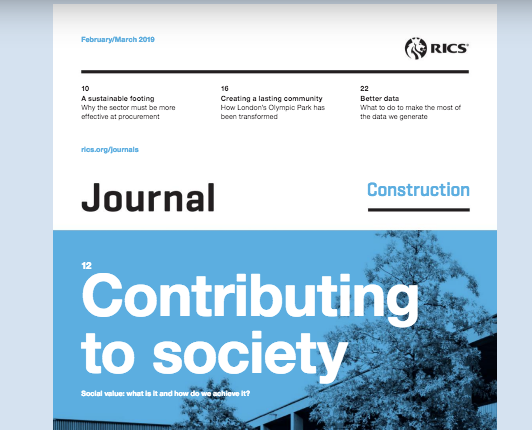Submitted by L. Millard on Wed, 30/01/2019 - 13:34
This month’s Royal Institute of Chartered Surveyors (RICS) Construction Journal features an article written by Dr Jennifer Schooling stating the case for securing better value from data.

The February issue of Construction Journal explores the ways in which we shape buildings and they, in turn, shape us. In the article titled ‘Better Data’ Dr Schooling considers the opportunity presented by data generated by the construction and infrastructure industries to gain unparalleled insights into the way our infrastructure is performing, how it is being used and whether it is fit for the future.
Dr Schooling writes: “Currently, we often use monitoring data to assess whether a particular quantity or property falls above or below a certain threshold, which then highlights whether there is an issue with the asset. After doing so, we typically dispose of the data or archive it in such a way that it is not easy to retrieve. We are not looking beyond the task in hand.”
Realising the full value of the data generated requires changing the way data is perceived, managed and valued: “We need to make the most of our data, and this requires us to identify what information we want from the data we collect, process it accordingly and make it accessible for future reference.” Securing richer information enables better decision-making and asset management allowing an informed understanding of how urgently an issue needs to be addressed and to plan accordingly.
Working more sustainably requires increasing capacity from existing assets “through the digital enhancement of mature infrastructure”. This, argues Dr Schooling, is crucial because “we cannot simply build our way out of a capacity constraint”. Pressure on resources as a result of increasing urbanisation as well as the imminent threat of climate change means “we have a responsibility to manage our use of carbon-intensive materials effectively and efficiently”.
The design and build of new infrastructure must, writes Dr Schooling, take into account “the value it provides throughout the whole life of the asset, not just for the lowest capital cost. This means considering the operational and maintenance costs at the design phase, and optimising for these costs as well as the cost of construction. Making better use of data throughout the infrastructure cycle is essential because it enables better decisions, which lead to better outcomes for those who will ultimately be using the asset”.
Information management is key to securing long-term value: “The challenge and the opportunity is to bring together people from the various points in an asset’s lifecycle to ensure the relevant data created during construction is secured, stored and curated for future use by asset managers and operators.” While driving change is not without challenge, steps are being taken by a number of industry organisations, including The Infrastructure Client Group’s Digital Transformation Task Group, to progress digital transformation strategies. Acknowledging that momentum is growing, Dr Schooling calls for collaboration: “Working together and pooling strategies will help build impetus and move us all in the right direction.”
Read the full article here.
